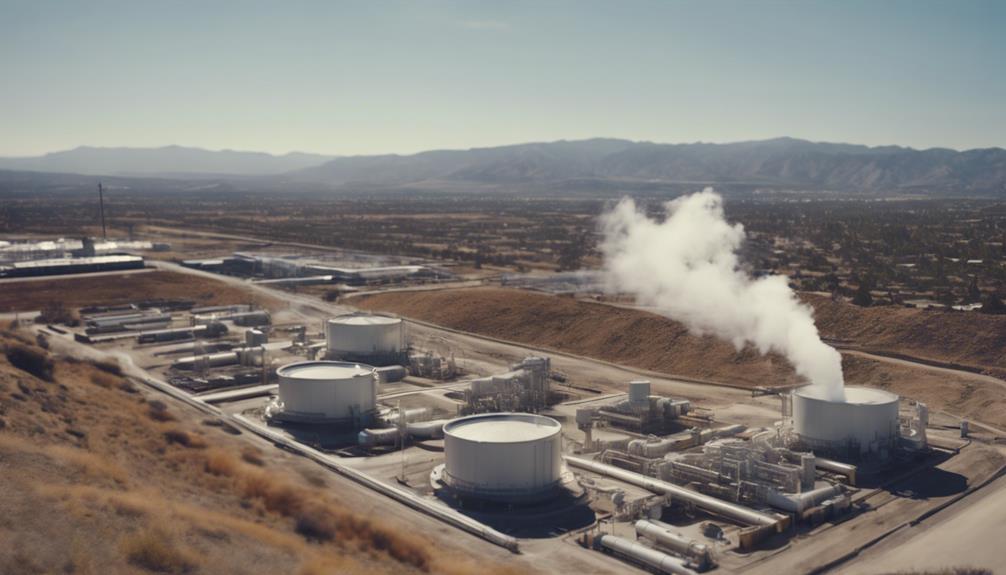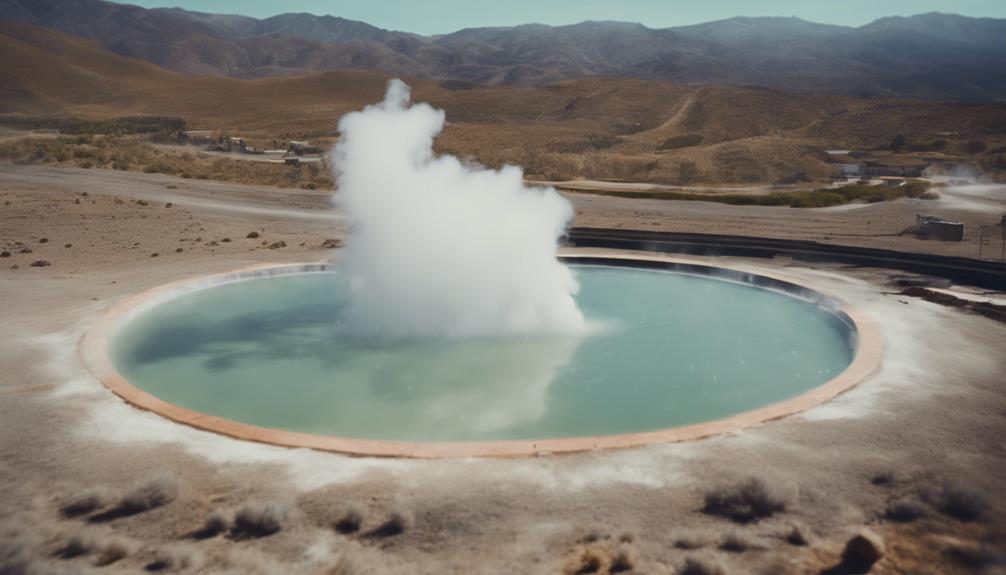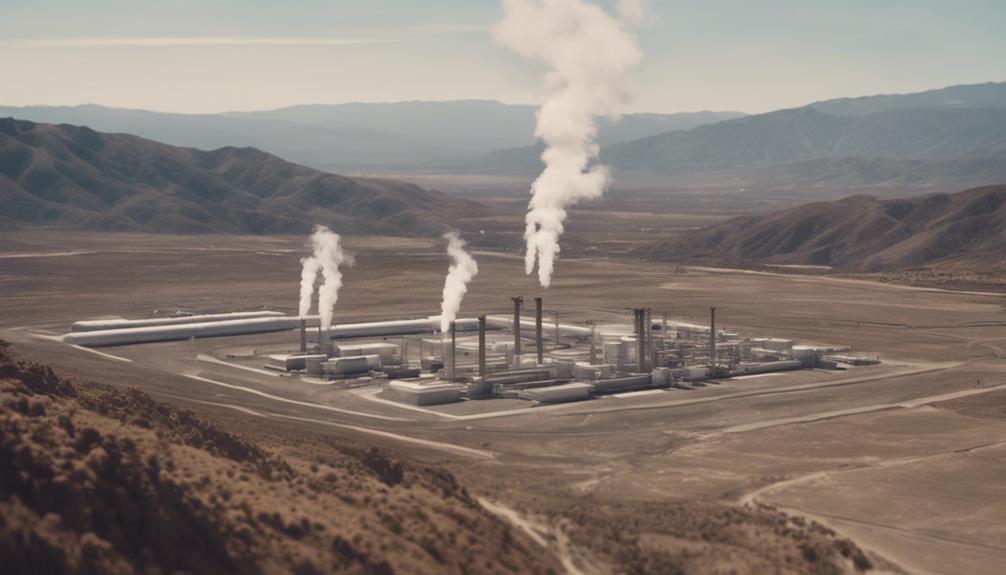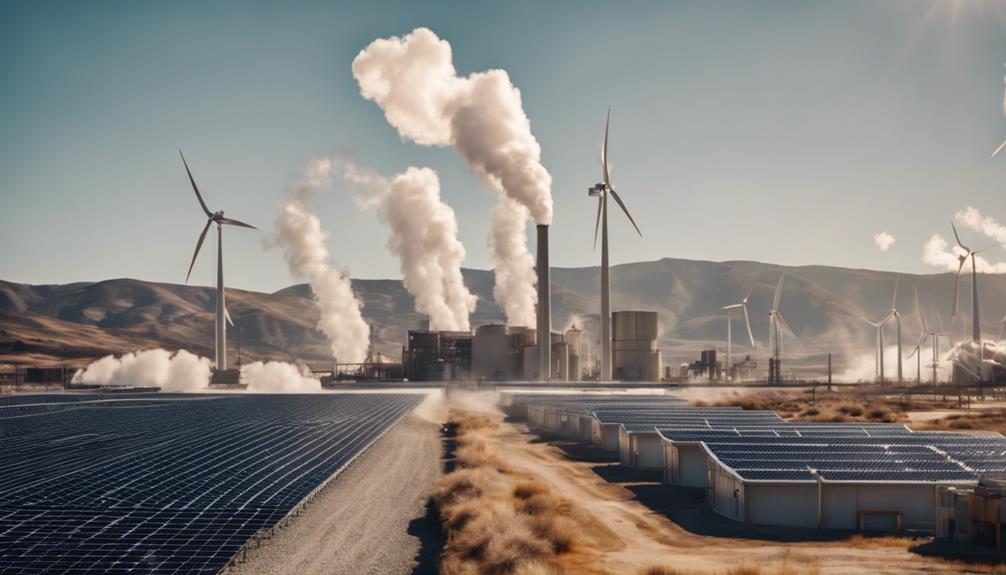California harnesses geothermal energy due to its abundant underground heat sources. The state's commitment to sustainability and reducing fossil fuel dependency aligns with geothermal energy production. With its vast potential, California aims to lead in clean energy solutions. If you want to discover more about the geothermal energy landscape in California, keep exploring the factors that drive its growth, from technological advancements to market trends and state initiatives.
Key Takeaways
- Abundant geothermal resources in areas like Imperial Valley and Geysers reservoir.
- State mandates for 100% clean energy by 2045 drive geothermal growth.
- California's focus on sustainable energy development promotes geothermal utilization.
- Technological advancements like horizontal drilling enhance geothermal access.
- Geothermal energy offers stable, reliable, and long-term clean power generation for California.
Geothermal Energy Potential in California
California boasts significant geothermal energy potential, with two of the largest geothermal reservoirs in the United States situated within its borders. The Imperial Valley stands out with an estimated untapped geothermal capacity ranging from 1,500 to 2,000 megawatts.
This vast potential contributes substantially to California's goal of fulfilling its energy needs, which currently stand at approximately 30,000 megawatts. The geothermal reservoirs at the Salton Sea and the Geysers showcase the state's commitment to harnessing renewable energy sources.
The Salton Sea reservoir alone has an impressive estimated generation capability of 2,200 megawatts, while the Geysers follow closely behind with 1,800 megawatts. With such abundant geothermal resources at its disposal, California is well-positioned to lead the way in sustainable energy development and reduce its reliance on fossil fuels.
The state's geothermal landscape presents a promising opportunity to further expand its renewable energy portfolio and move towards a greener future.
State Mandates and Geothermal Growth

To understand the significant impact of state mandates on geothermal growth in California, it's important to recognize the legislative push towards 100% climate-friendly electricity by 2045. California's commitment to this goal has propelled the development of geothermal energy in the state.
Three local energy providers have already signed contracts for new geothermal power plants, demonstrating a tangible step towards achieving renewable energy targets. Geothermal plants in California play a crucial role in generating emissions-free electricity continuously, meeting the state's energy demands sustainably.
State regulators are actively considering the possibility of doubling geothermal capacity on the main power grid by 2030, emphasizing the potential for further geothermal growth in California. Additionally, plans for two new geothermal power plants in Imperial County near the Salton Sea and Mono County are underway, indicating a strategic expansion of California's geothermal energy portfolio.
The state's unwavering focus on state mandates has unquestionably paved the way for substantial growth in geothermal energy production, solidifying its position as a leader in renewable energy initiatives.
Technological Advancements in Geothermal

You should know that the advancements in geothermal technology are revolutionizing the industry.
Innovations in drilling techniques and power plant systems are paving the way for more efficient geothermal energy production.
The ongoing push for innovation and growth is vital to accessing the full potential of geothermal power.
Enhanced Drilling Techniques
Developments in enhanced drilling techniques, particularly horizontal drilling, are revolutionizing the efficiency and productivity of accessing geothermal reservoirs. Fervo Energy, a key player in the geothermal energy sector, is at the forefront of developing innovative drilling technologies to unleash geothermal potential.
By employing horizontal drilling, geothermal wells can reach deeper and hotter rock layers, enabling the utilization of enhanced geothermal systems. These advancements not only aim to increase the productivity of geothermal wells but also extend their lifespan.
Through technological improvements in drilling methods, the geothermal energy industry is experiencing a significant boost in production and viability. The utilization of horizontal drilling techniques showcases the commitment of industry leaders like Fervo Energy to push the boundaries of geothermal exploration and extraction, ensuring a sustainable and efficient path towards harnessing geothermal energy.
Geothermal Power Innovation
Fervo Energy's innovative drilling technologies are paving the way for significant advancements in geothermal power innovation, propelling the industry towards increased efficiency and capacity utilization.
The geothermal sector, pivotal for renewable energy goals, necessitates continuous innovation to realize its full potential.
Initiatives like the Department of Energy's FORGE program are instrumental in supporting technological advancements in geothermal power generation.
By embracing cutting-edge solutions such as binary cycle power plants and enhanced geothermal systems, the industry holds promise for expanding capacity and driving down costs.
Geothermal advocates are optimistic that ongoing innovation won't only spur industry growth but also enhance competitiveness in the renewable energy landscape.
With a focus on research and development, geothermal power plants are poised to benefit from these technological advancements, ensuring a sustainable and efficient energy future.
Market Trends in Geothermal Energy

Exploring the market trends in geothermal energy reveals a growing interest in sustainable power sources within California's energy landscape. Here are some key insights into the market trends in geothermal energy within California:
- California's Renewable Energy: Geothermal energy plays a significant role in California's renewable energy portfolio, accounting for 22% of the state's renewable power generation.
- Geothermal Resources: The untapped geothermal capacity in the Imperial Valley alone ranges from 1500 to 2000 megawatts, meeting a portion of California's substantial demand for 30,000 megawatts of power.
- Energy is Produced: Geothermal facilities in California provide stable, baseline power 24/7, offering a reliable alternative to traditional energy sources like natural gas and coal.
- Geothermal Facilities: These plants have minimal wildlife siting concerns and can be efficiently located on uneven desert terrain with small footprints, showcasing the environmental advantages of geothermal energy production.
Geothermal Resources and Innovation

You can explore how geothermal innovation trends are shaping the utilization of resources in California, driving advancements in technology and efficiency.
The state's commitment to expanding geothermal capacity highlights a strategic focus on innovation to meet growing energy demands sustainably.
Geothermal Innovation Trends
In the field of geothermal energy, continuous innovation remains paramount for advancing resource utilization and enhancing efficiency. Geothermal Innovation Trends are shaping the industry's future, with exciting developments on the horizon:
- Fervo Energy: Leading the way in pioneering horizontal drilling techniques for geothermal reservoirs, Fervo Energy is revolutionizing the sector by boosting energy production efficiency.
- Technology Advancements: The geothermal industry relies heavily on technological progress to expand its capacity and meet the growing energy demands of the future.
- Capacity Growth: The Department of Energy projects that the U.S. geothermal capacity could soar to 60,000 megawatts by 2050 if innovation continues at its current pace.
- Market Expansion: With states in the American West, such as California, setting ambitious clean energy targets, the market for geothermal energy is expected to flourish, supported by competitive costs and increasing interest from energy providers.
Resource Utilization Strategies
Geothermal Resource Utilization Strategies in California are driving innovation and maximizing the state's geothermal potential for sustainable energy generation. With a focus on expanding capacity on the main power grid and tapping into an estimated 15,000 megawatts of untapped geothermal potential, California is positioning itself as a leader in geothermal energy production.
The Department of Energy's support for initiatives like FORGE is fostering technological advancements within geothermal plants, enhancing efficiency and output.
Market demand for geothermal power in California is on the rise, fueled by ambitious climate change policies and the state's commitment to achieving 100% climate-friendly electricity by 2045. By leveraging resource utilization strategies and fostering innovation, geothermal energy has the potential to play a significant role in California's electricity generation landscape.
Continued focus on these strategies will be essential in harnessing the full power of geothermal resources in the state.
California's Geothermal Grant Program

The California Energy Commission's Geothermal Grant Program plays a pivotal role in fostering the growth of geothermal projects statewide. Here's what you need to know about this program:
- Support for Projects: The California Energy Commission offers grants and loans through the Geothermal Grant Program to support geothermal projects, providing essential financial assistance for initiatives in the geothermal energy sector.
- Development Focus: With a primary goal of increasing the development and utilization of geothermal resources in California, the program actively encourages the exploration and advancement of geothermal technologies.
- Funding Opportunities: Funding from the program is available for various stages of geothermal projects, including exploration, development, and the demonstration of innovative geothermal technologies.
- Eligible Recipients: Businesses, local governments, and tribal organizations are among the eligible recipients of the Geothermal Grant Program, ensuring a broad reach and diverse participation in the state's geothermal energy initiatives.
Benefits and Challenges of Geothermal

One significant advantage of geothermal energy is its reliability and minimal environmental impact compared to other energy sources. Geothermal plants offer baseload power, which helps stabilize the grid and complements intermittent renewable sources like solar and wind energy. This stability makes geothermal a pivotal player in the shift to cleaner energy sources. Additionally, geothermal energy has economic benefits due to its long operational life and low operating costs once operational, making it a cost-effective option in the long term. However, geothermal energy also comes with challenges such as high initial costs, site-specific limitations, and potential subsurface risks that must be carefully managed. By addressing these challenges effectively, we can harness the full potential of geothermal energy and contribute to a cleaner and more sustainable energy future.
| Benefits | Challenges | |
|---|---|---|
| Clean Energy | High initial costs | |
| Baseload Power | Site-specific limitations | |
| Economic Benefits | Potential subsurface risks |
Frequently Asked Questions
What Makes California a Leader in the Production of Geothermal Energy?
California leads in geothermal energy due to abundant resources like the Geysers and Salton Sea. With 22% of the state's renewable power from geothermal, it offers stable energy. Ideal locations enable harnessing, setting California apart.
What State Is #1 in Geothermal Energy?
When it comes to geothermal energy, California takes the crown as the number one state in the US. The Golden State's abundant geothermal resources pave the way for sustainable and reliable power production.
How Much of California's Energy Is Geothermal?
California, you have approximately 22% of your energy from geothermal sources. With an estimated 1,500-2,000 megawatts of untapped capacity in Imperial Valley, geothermal power offers stable, reliable energy to meet your demand.
Is Geothermal Available in California?
Yes, geothermal is available in California, especially in regions with active or dormant volcanoes. Harnessing this renewable resource contributes notably to the state's energy goals. Many operating geothermal power plants utilize California's abundant geothermal potential.
What Factors Make California Ideal for Geothermal Energy Production?
California’s ideal geothermal energy production is attributed to its location near tectonic plates, providing ample geothermal energy resources. The state’s geothermal potential is bolstered by hot water reservoirs and steam fields, offsetting geothermal energy limitations near tectonic plates. This makes California a prime location for sustainable energy production.
Conclusion
So, why does California have geothermal energy?
The state's abundant geothermal resources, combined with government mandates and technological advancements, have fueled the growth of this renewable energy source.
With market trends and innovation driving further development, California's geothermal grant program offers support for continued expansion.
The benefits of geothermal energy are clear, but the challenges remain.
Will California continue to lead in geothermal innovation and sustainability? Only time will tell.









